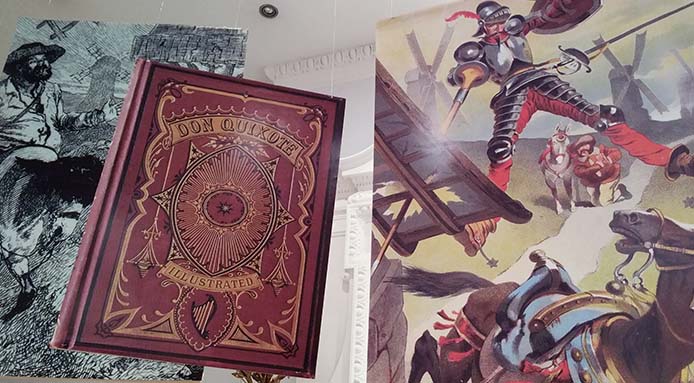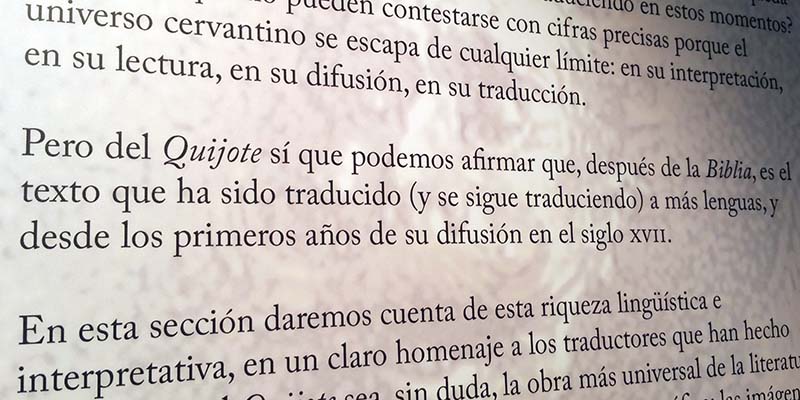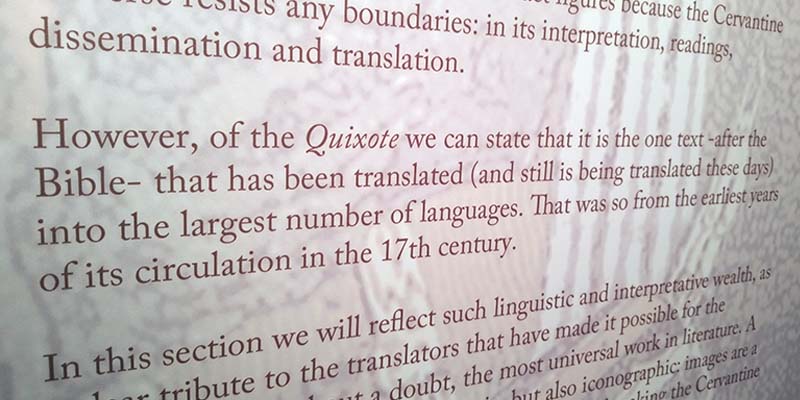Conferencia inaugural de «Quijotes por el mundo» / Don Quixotes Around The World Opening Lecture
El ministro de España en el Reino Unido, Federico Trillo, la directora de Cultura del Instituto Cervantes, Beatriz Hernanz, el comisionado de la exposición «Quijotes por el mundo», el cervantista y catedrático José Manuel Lucía Megías, y el más conocido traductor contemporáneo del Quijote de Cervantes al inglés, John Rutherford, han inaugurado la exposición «Quijotes por el mundo» compartiendo su experiencia personal con el mundo de Don Quijote de la Mancha y analizando la aportación de Cervantes a la literatura mundial a través de su obra maestra.
«Quijotes por el mundo» es un tributo a Miguel de Cervantes en el IV centenario de su muerte y un reconocimiento a todos los traductores que han contribuido a que, con 172 variantes dialectales de 147 lenguas distintas, «El ingenioso hidalgo don Quijote de la Mancha» sea la obra más traducida del mundo después de la Biblia.
_________________________________________________________________
_________________________________________________________________
Spanish Ambassador in the United Kingdom Federico Trillo, the Head of Culture of the Instituto Cervantes Beatriz Hernanz, the comissioner of the Don Quixote Around The World exhibition Jose Manuel Lucia Megias, and the most well-known contemporary translator of Don Quixote into English Prof. John Rutherford, opened the Don Quixotes Around The World exhibition to the public by sharing their personal experiences with Don Quixote and commenting on Cervantes’s contribution to worldwide literature through it.
Quixotes Around The World is a tribute to Miguel de Cervantes on the IV centenary of his death and a global recognition of all the translators who, having translated Cervantes’s masterpiece into 147 different languages and 172 dialectal variations thereof, have contributed to turning The Ingenious Gentleman Don Quixote Of La Mancha into the second most translated book in the world after the Bible.
«Quijotes por el mundo», el alcance del Quijote de Cervantes / Don Quixotes Around The World, The Scope Of Cervantes’s Masterpiece
En el marco del IV centenario de la muerte del autor hispano más universal, Miguel de Cervantes, en el Instituto Cervantes de Londres hemos inaugurado «Quijotes por el mundo» (exposición comisionada por el catedrático y cervantista José Manuel Lucía Megías), un reconocimiento del alcance de la obra de Cervantes y, a su vez, un tributo a los muchísimos traductores que, desde el sXVII y hasta la actualidad, han invertido su tiempo en hacerla crecer hasta convertirla en un fenómeno cultural global. Mientras estás leyendo estas líneas, alguien en alguna parte del mundo está traduciendo un fragmento de la obra más conocida de Cervantes.
Tras años de investigación y recopilación documental, se ha podido constatar que «El ingenioso hidalgo Don Quijote de la Mancha» de Miguel de Cervantes existe en 172 variedades lingüísticas de 147 lenguas: esta cifra la convierte oficialmente en la obra más traducida del mundo después de la Biblia.
Durante la investigación, se ha observado también que cada traducción e ilustración a lo largo de la historia ha adaptado el personaje del Quijote, su vocabulario, aspecto e indumentaria, al contexto histórico y social del entorno en que se hablaba dicha lengua, hasta hacer universales los valores y lecciones impartidas -y aprendidas- por el particular caballero. En 1863, fue Gustave Doré quien unificara la imagen y figura de Don Quijote, ilustrando y dando así vida al flaco hidalgo y su rechoncho escudero Sancho Panza que conocemos en la actualidad.
Niños, jóvenes y adultos de todo el mundo, durante 400 años, han transcrito, traducido, ilustrado e interpretado en pantalla al Quijote. Ven a ver una muestra de algunas de esas interpretaciones, leer el Quijote en braille y escuchar lecturas de fragmentos de «El ingenioso hidalgo Don Quijote de la Mancha» en otros idiomas: la entrada es libre y la exposición estará abierta en nuestro auditorio hasta el 10 de junio 2016.
Así es «Quijotes por el mundo»:
_____________________________________________________________________________
_____________________________________________________________________________
_____________________________________________________________________________
To mark the IV centenary of the passing of the most universal Hispanic author, Miguel de Cervantes, at the Instituto Cervantes in London we launched the exhibition Don Quixotes Around The World (commissioned by prof. Jose Manuel Lucia Megias, lecturer and Cervantes specialist), with the aim of illustrating the span of Miguel de Cervantes’s most renowned work and paying homage to all those translators involved in its growth over time. As you read these lines, someone, somewhere in the world is working on a translation of an excerpt of Cervantes’s stellar piece of writing.
After a lengthy focus on the compilation of worldwide takes on this book, it has been ascertained that The Ingenious Gentleman Don Quixote Of La Mancha by Miguel de Cervantes has been translated to 172 dialectal varieties of 147 different languages, thus officially becoming the second most translated book in the world after the Bible.
Research also showed that past translations and illustrations of Don Quixote had adapted its main characters’ clothes, vocabulary and overall looks to the historical and social context of the region where the target language was spoken at the time. The hundreds of translators and illustrators of Cervantes’s work throughout history have helped make Don Quixote’s values and lessons universal. It was Gustave Doré who unified the aspect of the book’s characters in 1863, thus creating the slim gentleman Don Quixote and his chubby squire Sancho Panza, nowadays adopted worldwide.
For 400 years, children, teenagers and adults the world over have transcribed, translated, drawn and played Don Quixote on screen. Come watch samples of some of those interpretations, read don Quixote in braille and hear excerpts of The Ingenious Gentleman Don Quixote Of La Mancha read in other languages: admission is free and the exhibition is open at our centre until 10 June 2016.
Here is what you will find at Don Quixotes Around The World (introduction in Spanish):






